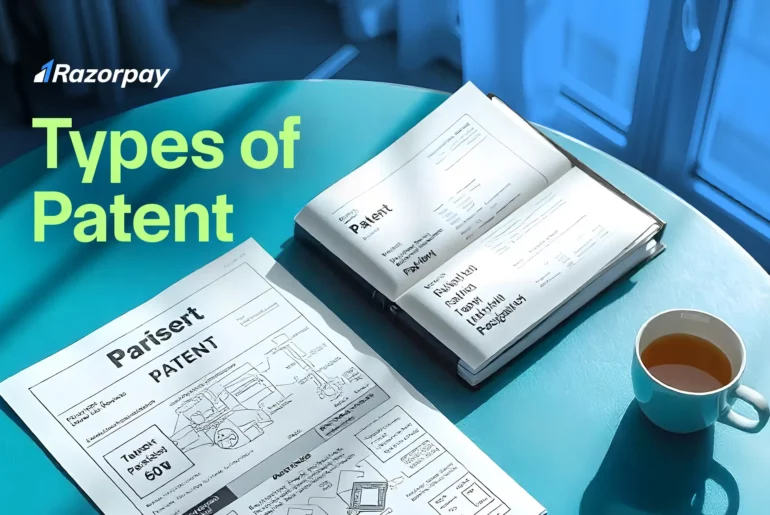Patents are the foundation of innovation, providing innovators exclusive rights to their inventions. Various patents are available to safeguard discoveries, such as innovative designs, ground-breaking technologies, or new plant varieties.
Selecting the appropriate patent is essential since it can protect your invention and provide a competitive advantage. Let’s examine the different types of patents and how to choose the most appropriate one for your invention.
Table of Contents
What are the 4 Types of Patents in India?
The Patents Act of 1970 outlines four primary types of patents in India: utility patents, design patents, plant patents and Provisional patents.
- Utility patents protect new inventions, processes, and methods of production.
- Design patents focus on safeguarding the aesthetic aspects of a product.
- Plant patents are granted for new and distinct varieties of plants.
- Provisional patents secure an early filing date temporarily for an Innovation.
The patenting process also involves several types of patent application, including Provisional Patents, which enable inventors to secure a filing date while finalizing their discoveries.
Here’s a detailed overview of the different types of patents in India:
1. Utility Patent
A utility patent protects new and valuable discoveries such as machinery, compositions of materials, methods, or improvements. Utility patents are also known as “patent for an invention”.
Utility patents focus on the practical features of inventions, unlike design patents that protect the aesthetic aspects.
A utility patent is a legal right granted under India’s Patents Act of 1970, which grants exclusive rights to the inventor for 20 years from the filing date, provided annual maintenance fees are paid.
1.1 Examples of Utility Patents
- Anti-cancer drug Imatinib Mesylate, protected for its unique formulation.
- Bt Cotton technology, recognized for enhancing pest resistance.
Utility patents play a crucial role in safeguarding useful inventions and promoting innovation in India.
1.2 Benefits of Utility Patents
Protection of Innovations against Unauthorized Production
Utility patents grant inventors the sole right to their creations, shielding their innovations against unauthorized production, use, or sale. Inventors are encouraged to devote time and resources to creating new concepts because they know their efforts will pay off financially.
Encouragement of Research and Development (R&D)
Utility patents, which grant exclusive rights, incentivize businesses to conduct R&D, eventually resulting in breakthroughs in several industries, including manufacturing, technology, and healthcare.
Attracting Investment from Companies and Financiers
New ventures and companies with patents on their products are frequently more appealing to financiers. Patents are essential assets that can boost a business’s worth and give it a competitive advantage.
Encouraging Partnerships and Licensing
Utility patents can provide businesses access to partnerships and licensing arrangements. Patent holders can license their creations to third parties, which makes money and lets other companies use their technology. This cooperative strategy may spur additional innovation and commercial growth.
2. Design Patent
Design patents are intellectual property rights that protect a product’s distinctive ornamental features, such as shape, pattern, or color palette, unlike utility patents, which cover functional aspects, design patents focus on artistic and aesthetic qualities.
Design Patent in India are granted under the Designs Act of 2000, which grants protection lasting 15 years from the registration date, prohibiting unauthorized parties from copying or using the design.
Industries covered by the design patent include fashion, consumer electronics, furniture, and packaging.
2.1 Examples of Design Patent
- Apple iPhone design patent (U.S. Patent No. D604,305) protects its distinctive shape and front panel aesthetics.
- Nike Air Force 1 (U.S. Patent No. D263,539) covers the iconic sneaker’s unique silhouette.
- Lego brick design patent (U.S. Patent No. D478,968) protects its classic interlocking shape.
2.2 Benefits of Design Patents
Design patents are essential for the following reasons:
Protection of Original Designs from Unapproved Usage
Patents on designs offer legal defense against unapproved usage, copying, or counterfeiting of designs. Ensuring inventors maintain exclusive rights to their unique designs encourages creativity and innovation across various industries.
Commercial Advantage through Increase in Market Worth
Obtaining a design patent raises a product’s market worth. Customers are drawn to distinctive and eye-catching designs, which aid companies in setting their goods apart in a competitive market. Increased sales and brand loyalty may result from this competitive edge.
Boosting Brand Identity and Consumer Loyalty
Design patents partly establish a strong brand identity. A distinctive design has the power to associate a brand with itself, giving people easy access to it. This acknowledgement may result in increased repeat business and consumer loyalty.
3. Plant Patent
A plant patent is an intellectual property right that safeguards the unique characteristics of a new plant, preventing others from copying, selling, or using it without permission. plant patent grants exclusive rights to inventors who discover or develop novel plant species.
Plant patents are Governed by the Plant Varieties and Farmers’ Rights Act, 2001 (PPV&FR Act) in India, plant patent protects both asexually and sexually reproduced plant types that meet specific criteria:
1. Novelty
2. Distinctness
3. Uniformity
4. Stability
Plant patent is developed to comply with international agreements, such as the TRIPS Agreement (Trade-Related Aspects of Intellectual Property Rights). Plant patent ensures adequate protection for plant varieties while recognizing the rights of farmers and breeders.
3.1 Examples of Plant Patents
- High-yielding hybrid rice variety Pusa 44 (Indian Agricultural Research Institute).
- Kesar Mango (known for its distinct flavor).
- Colorful Gerbera daisies.
- Pest-resistant types of eggplant.
3.2 Benefits of Plant Patents
Plant patents are essential to farmers, breeders, and the agriculture industry in general for several important reasons:
Protection of Breeders’ Rights from Unapproved Sale or Use
Plant patents offer breeders legal defense by prohibiting their patented plant types’ unapproved use, sale, or reproduction. This protection ensures breeders can profit monetarily from their labour, promoting innovation.
Facilitation of Commercialization and Promotion of New Plant Varieties
Plant patents help breeders successfully market their new varieties. Breeders may confidently promote their plants and boost sales and profitability by safeguarding their intellectual property.
Contribution to Economic Growth, Innovation and Commercialization
Plant patents support agricultural innovation and commercialization, which advances economic growth. Introducing novel plant types can boost agricultural output, create jobs, and improve the standard of living for farmers and breeders.
4. Provisional Patent
A provisional patent application (PPA) is an initial filing that provides inventors with a 12-month window to secure a filing date for their invention while allowing time for further development. To maintain the benefits of this early filing date, a complete non-provisional patent application must be submitted within the 12-month period.
Filing provisional patent avoids the formalities associated with a regular patent application. It provides a “patent pending” status, which is advantageous when seeking partners or investors.
4.1 Examples of Provisional Patent
- A provisional patent for a social networking app that connects users based on shared interests.
- A provisional patent for a smartwatch that tracks heart rate, sleep patterns, and physical activity.
4.2 Benefits of Provisional Patent
Provisional patents are essential to inventors and businesses for several important reasons:
Early Filing Date
A provisional patent’s main benefit is setting an early filing date. In nations where the “first to file” rule is in effect, it protects the inventor’s rights from possible rivals.
Cost-effectiveness
Filing a provisional patent typically costs less than submitting a complete, non-provisional patent application. This allows innovators to preserve their ideas and avoid paying expensive legal fees and other patent-related expenses.
Flexibility for Development
Inventors can do market research, refine their ideas, and look for funding during the 12-month term granted by a provisional patent, all without rushing to submit a fully developed non-provisional application immediately.
Related Read: What is Letters Patent?
How to Choose the Right Type of Patent? A Step-by-Step Guide
STEP 1: Understand Your Invention
Evaluate the Nature of Your Invention
Identify whether your invention is a new process, product design, or a distinct plant variety.
Determine Key Features
Assess whether the focus is on functionality, aesthetic appeal, or botanical characteristics.
STEP 2: Familiarize Yourself with Patent Types
Utility Patent
Suitable for inventions that are functional or provide a specific utility. Offers broad protection for 20 years.
Design Patent
Ideal for inventions focusing on ornamental designs or aesthetics. Protection lasts for 15 years.
Plant Patent
Designed for new, distinct plant varieties. Offers protection for 20 years.
STEP 3: Assess the Scope of Protection Needed
Features to be Considered
- Functional aspects (utility patent)
- Aesthetic aspects (design patent)
- Plant characteristics (plant patent)
Identification of Market Competitors
Analyze what competitors are protecting to determine the necessary scope for your patent.
STEP 4: Evaluate the Strength of Protection
Consider Enforceability
1. Utility patents are generally easier to enforce due to their broad scope.
2. Design patents may face challenges if the design isn’t distinctive enough.
Review Existing Patents
Check if similar patents exist and how they are classified to understand your invention’s position.
STEP 5: Analyze Commercial Goals
Determine if your goal is to
- Protect a core innovation
- License your invention for income
- Create a competitive edge in the market
Consider Long-term Goals
Evaluate how the patent type aligns with your business’s growth plans.
STEP 6: Consult a Patent Attorney
Seek Expert Guidance
A patent attorney can help you navigate patent law and choose the most suitable type for your invention.
Discuss Specifics
Provide details about your invention, market goals, and competitors to receive tailored advice.
STEP 7: Prepare and File Your Patent Application
Gather Required Documentation
Collect all necessary information, including descriptions, drawings, and claims.
Select the Appropriate Application Type
Decide if you will file a provisional patent (for initial protection) or a complete patent application.
File with the Appropriate Patent Office
Ensure you follow all filing requirements and deadlines for your chosen patent type.
STEP 8: Monitor and Maintain Your Patent
Track Application Progress
Stay informed about your patent application’s status.
Pay Maintenance Fees
Ensure you pay any necessary fees to keep your patent active.
The Importance of Choosing the Right Patent
Selecting the right patent type from the above given types of patents in India guarantee an invention’s adequate protection. It establishes the extent of defense, the potency of the legal defense, and the capacity to uphold rights. Selecting the appropriate patent category (plant, utility, or design) guarantees thorough protection against infringement or unauthorized use.
The choice of patent type directly affects the scope and enforceability of the patent:
1. Scope
While design patents are restricted to visual design, utility patents provide extensive protection encompassing multiple functional features. Making the correct choice guarantees the safety of all the invention’s essential features.
2. Strength
A well-selected patent type enhances the inventor’s position by offering a solid defence against infringement. On the other hand, a design patent simply guards against copying the distinctive appearance, whereas a utility patent provides a solid platform for safeguarding technological innovations.
3. Enforceability
A patent’s enforcement capacity is directly related to its classification. Because of their broad coverage, utility patents are typically easier to enforce than design patents, which may encounter difficulties if the design needs to be sufficiently unique.
Selecting the wrong type of patent can have disastrous effects on inventors. For example, competitors may readily produce functionally equivalent things without infringing on the patent, damaging the inventor’s market position if the inventor files for a design patent that only protects the aesthetic features of a product.
Furthermore, unclear claims in poorly written patents can lead to legal conflicts in which the patent holder finds it challenging to establish infringement or maintain the validity of the invention.
Thus, inventors should carefully weigh their alternatives and speak with a patent attorney to protect their ideas. An attorney can offer professional help in navigating the complexity of patent law.
Related Read: How to Apply and File a Patent in India in 2025?
Conclusion
Selecting the appropriate patent type is essential to protecting your innovation and gaining a competitive advantage. Every patent provides different safeguards, ranging from protecting new plant types to safeguarding inventive and practical inventions.
By being aware of these differences and getting professional guidance, you can ensure your intellectual property adequately safeguards the way for future success and innovation.
Frequently Asked Questions
1. What is the most common type of patent?
The most common type of patent is utility, which protects functional and practical inventions. These patents require a thorough analysis process and maintenance fees but provide broader protection than design or plant patents.
2. How do these types of patents differ from each other?
Utility patents protect new and useful inventions or processes, offering exclusive rights for 20 years from the filing date. On the other hand, design patents safeguard a product’s ornamental design for 15 years, while plant patents are granted for new and distinct plant varieties that are asexually reproduced and also last 20 years.
3. Which type of patent is most suitable for a given invention or design?
A utility patent is most suitable for inventions focusing on functionality, while design patents are awarded for innovation in aesthetics.
4. What is the application process for different types of patents in India?
Utility patent requires sending the patent office a thorough application that includes claims and illustrations. A design patent requires a description and drawings of the ornamental design. Plant patents require specifics regarding the plant’s traits and an in-depth account of the breeding procedure.
5. Are there any other specialized patents besides the main types?
Yes, there are a few specialized patent types. They are continuation patents and divisional patents. Continuation patents add new claims to an already filed application without requiring a new filing, and divisional patents divide a patent application into several applications to cover distinct facets of the original invention.





